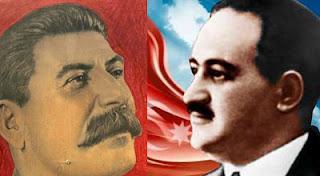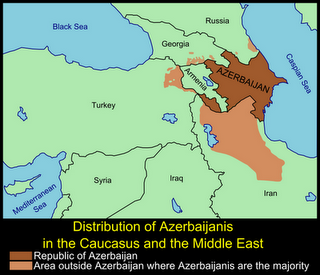 Despite the loss of Nagorno-Karabakh, de facto independent from 1994, Azerbaijan is still the largest and most populated among the former Soviet republics of the South Caucasus. Established in 1918, the Azerbaijan Democratic Republic was the first secular state in the Muslim world, though its existence was very short due to Soviet annexation two years later. Thanks to its energy resources, today’s Azerbaijan is a strong, independent country inhabited by roughly 10 million people, 90 percent of whom are Azerbaijanis. Nevertheless, a much greater number of ethnic Azerbaijanis live outside the borders of the republic and especially in Iran, where they are thought to be more than 15 millions, thereby constituting more than half of the so-called Whole Azerbaijan.
Despite the loss of Nagorno-Karabakh, de facto independent from 1994, Azerbaijan is still the largest and most populated among the former Soviet republics of the South Caucasus. Established in 1918, the Azerbaijan Democratic Republic was the first secular state in the Muslim world, though its existence was very short due to Soviet annexation two years later. Thanks to its energy resources, today’s Azerbaijan is a strong, independent country inhabited by roughly 10 million people, 90 percent of whom are Azerbaijanis. Nevertheless, a much greater number of ethnic Azerbaijanis live outside the borders of the republic and especially in Iran, where they are thought to be more than 15 millions, thereby constituting more than half of the so-called Whole Azerbaijan.
This geopolitical concept was formulated in 1992-1993 by the former Azerbaijani president Abulfaz Elchibey, who later founded an organisation called Whole Azerbaijan Union. In his book on the idea, Bütöv Azərbaycan Yolunda, the statesman argued that the borders of Azerbaijan should extend from Derbent to the Persian Gulf, claiming that Azerbaijanis, with historical presence in the region, had right to rule over it with a proposed system of governance: the United Azerbaijani Lands.
Half a century earlier than Elchibey, plans for the creation of a Greater Azerbaijan had already been drafted by another statesman: Iosif Vissarionovich Dzhugashvili, better known as Stalin. According to a 2009 research conducted by Dzhakhangir Nadzhafov, a scholar at the Moscow Institute of General History, the bolshevik leader actually viewed the secret protocols of the Molotov-Ribbentrop Pact, which allowed Moscow to seize the Baltic countries, Bessarabia and Eastern Poland, as “a model” for the further annexations in Iran, Turkey and China.
In 1941 – Nadzhafov writes – the boss of the Communist Party in Azerbaijan, Mirdzhafar Bagirov, invoked Stalin by stating that “in Iran it is necessary to undertake the tactic and strategy of the model of uniting Polish territories to Ukraine and Belorussiya,” an indication that Moscow’s plans for annexing portions of Iran were “practically ready.” The evidences found by Nadzhafov and published in Voprosy istorii, the oldest Russian academic history journal, also suggest that the Soviet leadership planned to annex completely the Turkish districts of Kars, Ardahan and part of Avdina, dividing the 26,500 square kilometers of territory between Armenia and Georgia. As a result of the territorial transfers provided, the three republics of the South Caucasus would have expanded significantly, Armenia by 80 percent, Georgia by 8 percent, and Azerbaijan more than doubled.
The Politburo intended to annex the ethnically Azerbaijani region of Northern Iran on November 7, 1941, planning as well to assign names of Communist officials to the newly absorbed territories. Hitler’s invasion of the Soviet Union in June 1941 put all these plans on hold. To prevent Tehran’s alignment with the Axis Powers and allow Western supplies reaching safely the Soviet Union, in the summer of that year the Red Army occupied the northern part of Iran, letting British control over the rest of the country. Under allied pressure, Stalin did not have other choice but to recognize the territorial integrity of Iran in a trilateral agreement with the US and the United Kingdom in January 1942.
 Nevertheless, as Soviet forces moved westward and victory over Hitler seemed assumed, Stalin took up the Southern Azerbaijan project once again, not only because of the interest of many ethnic Azerbaijanis on both sides of the border, but especially because of the growing importance of oil located in the region. In November 1945, the Soviet dictator backed the creation of the Azerbaijan People’s Government, an entity which nevertheless ceased to exist one year later, following the withdrawal of the Red Army from the country.
Nevertheless, as Soviet forces moved westward and victory over Hitler seemed assumed, Stalin took up the Southern Azerbaijan project once again, not only because of the interest of many ethnic Azerbaijanis on both sides of the border, but especially because of the growing importance of oil located in the region. In November 1945, the Soviet dictator backed the creation of the Azerbaijan People’s Government, an entity which nevertheless ceased to exist one year later, following the withdrawal of the Red Army from the country.
Many scholars attribute the fall of the republic to a presumed negative attitude of Stalin, Beria, Mikoyan and other Soviet leaders toward Azerbaijan. Nevertheless, such conclusions “do not have any basis in fact,” as argued by Nadzhafov. Quite the contrary, the inclusion itself of the Armenian territories of Nagorno-Karabakh and Nakhchivan into the Azerbaijan Soviet Socialist Republic, and open support to Bagirov’s irredentistic policies, actually show Stalin’s benign attitude toward Azerbaijan. For this reason, the name of the Georgian leader should rather be included among the precursors of the idea of the Bütöv Azerbaycan, Elchibey’s Whole Azerbaijan.

